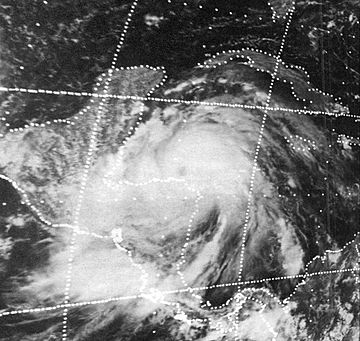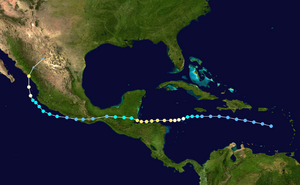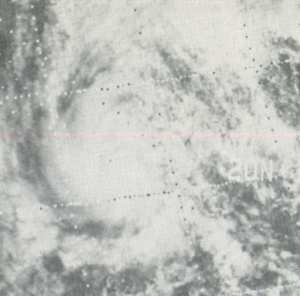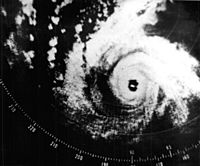Hurricane Fifi–Orlene facts for kids

Fifi at peak intensity just north of Honduras on September 18
|
|
| Formed | September 14, 1974 |
|---|---|
| Dissipated | September 24, 1974 |
| Fatalities | 8,210 (Third-deadliest Atlantic hurricane) |
| Damage | $1.8 billion (1974 USD) |
| Areas affected | Puerto Rico, Hispaniola, Jamaica, Nicaragua, Honduras, Belize, El Salvador, Guatemala, Mexico, Arizona |
| Part of the 1974 Atlantic and Pacific hurricane seasons |
|
Hurricane Fifi, later known as Hurricane Orlene, was a very powerful tropical cyclone in September 1974. It caused a lot of damage and sadly, over 8,000 people lost their lives in Honduras. This makes it the third deadliest Atlantic hurricane ever recorded. Only Hurricane Mitch (1998) and the Great Hurricane of 1780 were deadlier.
Fifi was also the first hurricane to cause over a billion dollars in damage without hitting the United States. It started as a strong tropical wave on September 14. This system moved west-northwest through the Caribbean Sea. On September 16, it became Tropical Storm Fifi near Jamaica. The storm quickly grew stronger, becoming a hurricane the next day.
On September 18, Fifi reached its strongest point as a powerful Category 2 hurricane. It stayed strong as it moved along the northern coast of Honduras. The hurricane then made landfall in Belize the next day. After hitting land, it quickly weakened. By September 20, it was just a tropical depression.
As it continued west, the storm interacted with another system in the Pacific Ocean. On September 22, Fifi became a tropical storm again. It then turned into a new tropical cyclone, named Tropical Storm Orlene. Orlene curved towards Mexico, quickly becoming a Category 2 hurricane before hitting land. It weakened after landfall and disappeared over the mountains of Mexico on September 24.
Hurricane Fifi–Orlene affected nine countries. It caused over 8,200 deaths and $1.8 billion in damages. Most of the deaths and damage happened in Honduras. Heavy rainfall, up to 24 inches (610 mm), caused widespread flash flooding and mudslides. In one town, thousands of people died overnight due to a massive flood. Fifi brought continuous rain for three days, making rescue efforts very difficult. This was the worst disaster in Honduras' history at the time. In nearby Guatemala, 200 people died from severe flooding. After the storm, relief groups from around the world sent help. Because of the huge damage and loss of life, the name Fifi was removed from the list of Atlantic hurricane names.
Contents
How the Storm Formed and Moved
Hurricane Fifi began as a tropical wave off the coast of Africa on September 8. Satellite images showed it was already well-developed. The wave moved west and entered the Caribbean Sea by September 13. Soon after, it started to grow stronger. On September 14, a US Navy plane found a developing low-pressure area. The National Hurricane Center (NHC) officially called it a tropical depression on September 15.
The depression continued to get more organized as it moved west. On September 16, it became Tropical Storm Fifi just south of Jamaica. About 24 hours later, it became a hurricane. At this time, it had an eyewall, which is a sign of a strong storm. The storm was not perfectly round. Its strong winds reached much farther north than south.
By September 18, Fifi reached its strongest point. It had winds of 110 mph (175 km/h). This made Fifi a high-end Category 2 hurricane on the Saffir–Simpson hurricane scale. The hurricane had almost doubled in size by then. Its strong winds covered an area 300 miles (480 km) wide.
Fifi could not get stronger because it was too close to land. The mountains of Honduras blocked part of its circulation. Fifi stayed at its peak strength for about 24 hours. It then weakened slightly before hitting land near Placencia, Belize, with winds of 105 mph (165 km/h).
After moving inland, Fifi weakened to a tropical storm. It then became a tropical depression over southwestern Mexico on September 20. Two days later, the storm moved back over water near Acapulco, Mexico. It was the third known tropical cyclone to cross Central America and enter the Pacific Ocean. When it was back over open water, Fifi became a tropical storm again. However, it was then renamed Orlene.
After becoming Orlene, the storm started to get stronger. On September 23, it became a hurricane. It quickly moved north-northeast. Just before hitting land, a small eye formed in the hurricane's center. This led the NHC to upgrade it to a Category 2 storm with winds of 105 mph (165 km/h). However, another agency reported its peak winds were 80 mph (130 km/h). Orlene quickly weakened after hitting land. It became a leftover low-pressure system just six hours later. The storm then disappeared over the mountains of Mexico.
What Happened in Different Places
Caribbean Islands
On September 15, the government of Jamaica started getting ready for the storm. People were told to watch out for heavy rain. Small boat warnings were also issued because of rough seas. Fifi passed south of Jamaica as a tropical storm. It brought heavy rains, over 8 inches (200 mm) in some places.
Severe flooding hit parts of Kingston. Some areas were under 2 feet (0.6 m) of water. Damages from the storm cost hundreds of thousands of dollars. Luckily, no one died in Jamaica. In nearby Hispaniola, the storm also caused moderate rain and flash flooding. Warnings were also issued for parts of southern Cuba and the Cayman Islands.
Honduras
| Deadliest Atlantic hurricanes | |||
|---|---|---|---|
| Rank | Hurricane | Season | Fatalities |
| 1 | ? "Great Hurricane" | 1780 | 22,000–27,501 |
| 2 | 5 Mitch | 1998 | 11,374+ |
| 3 | 2 Fifi | 1974 | 8,210–10,000 |
| 4 | 4 "Galveston" | 1900 | 8,000–12,000 |
| 5 | 4 Flora | 1963 | 7,193 |
| 6 | ? "Pointe-à-Pitre" | 1776 | 6,000+ |
| 7 | 5 "Okeechobee" | 1928 | 4,112+ |
| 8 | ? "Newfoundland" | 1775 | 4,000–4,163 |
| 9 | 3 "Monterrey" | 1909 | 4,000 |
| 10 | 4 "San Ciriaco" | 1899 | 3,855 |
Fifi became a threat to Honduras on September 17 when it reached hurricane strength. Forecasters expected it to hit Honduras or Nicaragua. Officials in Honduras told hundreds of thousands of people to leave coastal and flood-prone areas. However, not many people followed these warnings. This likely led to the high number of deaths.
On the first day, the region had winds up to 132 mph (212 km/h) and non-stop rain. Early reports from the Honduran government said 14 people had died. Over 100 people were missing. In just 24 hours, 182 towns and villages were completely destroyed. The Red Cross reported that between 800 and 1,200 people died within 12 hours of Fifi hitting Honduras. Buses driving in the mountains fell off cliffs because of slippery roads. Flash floods destroyed thousands of homes and cut off many towns. Waves, reaching 10 feet (3 m) high, destroyed docks and pushed many ships onto land.
Rain continued all day on September 19. This caused widespread mudslides that killed over 2,000 people. A huge mudslide blocked the Choloma River. This stopped water from the river and the 20 inches (510 mm) of rain from Fifi from reaching the ocean. The water was released on September 20 when a concrete bridge broke upstream. This sent a huge flood down the valley.
The city of Choloma was devastated. An estimated 2,800 to 5,000 people died out of a population of 7,000. The flood happened at night, so most people did not know it was coming.
Other towns along the coast suffered similar fates. In Armenta, about 400 families disappeared after a large landslide buried the town. The town of Omoa (population 2,500 to 3,000) was completely destroyed overnight on September 19. Most residents were thought to have died.
Even though the storm was over Mexico, its circulation still caused thunderstorms over Honduras. This made rescue efforts very difficult. Dense fog in the mountain valleys stopped nighttime rescues. The city of La Ceiba, with 53,000 people, was completely cut off.
The number of deaths grew by hundreds each day. At one point, the official death toll was as high as 10,000. The exact number of deaths from Fifi is still uncertain. Most estimates are between 8,000 and 10,000. This made Fifi the second-deadliest Atlantic hurricane at the time. It later became the third-deadliest after Hurricane Mitch in 1998 caused similar destruction.
Fifi caused nearly $1.8 billion (1974 US dollars) in damage in Honduras. This was the worst natural disaster in Honduras' history at the time. In some coastal areas, only buildings on higher ground were left standing. Many cities were more than 80% destroyed. Fifi ruined over 10,000 well-built homes. An estimated 150,000 people were left homeless. However, the Honduran government estimated that between 350,000 and 500,000 people lost their homes. The country's banana crop was completely destroyed. This severely affected Honduras' economy.
Other Central American Countries
| Precipitation | Storm | Location | Ref. | ||
|---|---|---|---|---|---|
| Rank | mm | in | |||
| 1 | 1597 | 62.87 | Mitch 1998 | Picacho/Chinandega | |
| 2 | 1447 | 56.97 | Aletta 1982 | Chinandega | |
| 3 | 674 | 26.55 | Eta 2020 | Puerto Corinto | |
| 4 | 500 | 19.69 | Joan 1988 | ||
| 5 | 447 | 17.60 | Gert 1993 | Chinandega | |
| 6 | 368 | 14.49 | Fifi 1974 | Chinandega | |
| 7 | 298 | 11.72 | Alma 2008 | Punto Sandino | |
| 8 | 272 | 10.70 | Cesar 1996 | Bluefields | |
| 9 | 231 | 9.10 | Ida 2009 | Puerto Cabezas | |
| 10 | 181 | 7.11 | Felix 2007 | Puerto Cabezas | |
Officials in Belize and Guatemala quickly prepared for the hurricane. Much of Central America north of Nicaragua was affected. Rain up to 4 inches (100 mm) fell as far north as Campeche, Mexico. In Chinandega, Nicaragua, the storm brought 14.5 inches (370 mm) of rain over four days. This heavy rain caused major flooding as many rivers overflowed. Hundreds of people lost their homes.
Communities like La Conquista and San Vicente were cut off by floodwaters. More than ten homes were destroyed in Chiquito, Izapa, and Tamarindo. After the Río Coco overflowed in Jinotega, 120 homes were destroyed. Hundreds of people in Wiwili held onto treetops and roofs along the Coco River.
Even though the storm hit Belize directly, the country had much less damage than Honduras. However, winds up to 109 mph (175 km/h) were recorded. The strong winds and heavy rains damaged or destroyed hundreds of homes. Waves along the coast were 12 feet (3.7 m) higher than normal. While Honduras got over 24 inches (610 mm) of rain, Belize only received about 6 inches (150 mm). The country's $800,000 banana crop was completely destroyed. Despite the severe damage, no deaths were reported in Belize.
In Guatemala, the weakened storm brought extreme rainfall. This caused widespread flash flooding. Many bridges, roads, and homes were washed away or destroyed. At least 200 people died, making Fifi the deadliest storm in Guatemala in nearly 20 years. In El Salvador, the outer parts of Fifi caused flooding rains that killed at least ten people.
Mexico and Arizona
As Fifi moved over Central America, its outer edges brought 4 inches (100 mm) of rain to areas as far north as Campeche. Mexico had little or no damage from Hurricane Fifi. However, once it became Hurricane Orlene, the storm hit the Pacific coast of Mexico as a Category 2 hurricane. There were no reports of deaths or major damage. In Acapulco, reports showed 11 inches (280 mm) of rain fell in six hours. Leftover moisture from the hurricane brought some rain to parts of Arizona.
After the Storm
| Region | Deaths | Damage |
|---|---|---|
| Jamaica | 0 | Thousands of dollars |
| Honduras | 8,000–10,000 | $1.8 billion |
| Nicaragua | 0 | Unknown |
| Belize | 0 | $800,000+ |
| El Salvador | 10 | Unknown |
| Guatemala | 200 | Unknown |
| Mexico | 0 | Unknown |
| Total | 8,210+ | $1.8 billion+ |
Because of the severe damage and many lives lost from Hurricane Fifi, its name was retired at the end of the 1974 season. This means the name Fifi will not be used again for Atlantic hurricanes. It was not replaced by a new name because the way Atlantic hurricanes were named changed in 1979.
Rebuilding Efforts
In 1977, a big project to rebuild six villages in Honduras began.
- The first area had 121 homes. It was near an important highway in northern Honduras.
- The second plan included 127 homes about a mile south of the first.
- The third project, with 26 concrete homes, was in the city of El Progreso. These homes were designed to house many people.
- The fourth project was in a rural area, far from cities. There, 92 homes were planned.
- The fifth project, with 33 homes, was close to the first project.
- The final and largest housing project was south of the destroyed town of Choloma. A total of 600 homes were built there.
On October 3, 1974, two Guatemalan businessmen, Dionisio Gutiérrez and Alfonso Bosch, died. They were flying to Honduras to help victims of Hurricane Fifi–Orlene. Their plane was carrying medicines collected by the Rotary Club of Guatemala. It crashed due to bad weather and cargo near the village of Las Nubes. The families of these men later created the Juan Bautista Gutierrez Foundation. This foundation helps organize social projects they had been doing for years.
See also
 In Spanish: Huracán Fifi-Orlene para niños
In Spanish: Huracán Fifi-Orlene para niños
- List of Category 2 Atlantic hurricanes
- List of Category 2 Pacific hurricanes
- Hurricane Keith (2000)
- Hurricane Iris (2001)
- Hurricane Manuel (2013)
- Hurricane Nana (2020)




